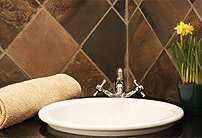By Rachel Bertsche

Turning your house into an eco-friendly space is a step-by-step process, but if you want to start out with a bang, hit the bathrooms
first. “As far as water use inside the home goes, the bathroom accounts for the largest share -- over 50 percent,” says
Crissy Trask, author of It's Easy Being Green: A Handbook for Earth-Friendly Living.
“Considerable water and money can be saved when you make a bathroom as water-efficient as possible, and many small fixes are extremely economical and can be done by the do-it-yourselfer.” To get started, try these inexpensive and easy suggestions to save energy and money every time you hit the showerhead.
1. Repair leaks.
A faucet that drips once every second wastes 3,154 gallons of water per year, and on average, anywhere from $22 to $93 annually. “A $2 washer and two minutes may be all that’s needed to stop it,” says Trask. “If it turns out to be a more complicated fix, even the cost of a plumber will be less than paying for the wasted water and energy year in and year out.”
Tougher to spot -- and much more wasteful -- is a leaky toilet, warns Trask. Since toilet leaks are often silent, she suggests running a simple test: Add a drop of food coloring to the inside of the tank. If 20 minutes later the water in the bowl is tinted, you’ve got a leak. “Fixing a toilet may require a bit of tinkering, but chances are good that you can do it without spending any money -- or very little,” she says.
2. Install a faucet aerator or a low-flow showerhead.
Both save water by restricting water flow and are easy to install. Aerators cost little and can be found at your local hardware store. “They’re rated for different flows, and a flow rate of 0.5 to 1 gallons per minute should be sufficient for a bathroom sink,” says Trask. When it comes to showerheads, it pays to be picky. “Don’t just shop around for the cheapest model you can find,” she warns. “You want a showerhead that provides enough pressure to rinse the shampoo out of your hair, and that means spending a little more for the aerated type.”
3. Use your overhead fan wisely
If you need a fan to control humidity, that’s OK, but don’t go crazy. Trask suggests getting one that’s on a timer so it will automatically shut off after 10 minutes. “That way it won’t stay on past its usefulness, and it won’t pull expensive heated or cooled air out of your house for longer than necessary.”
4. Upgrade your toilet.
If your toilet was installed prior to 1994, it uses two to seven times more water than modern toilets -- which means more waste and higher water bills. “Any toilet bought after 1994 uses 1.6 gallons per flush or less,” says Trask. “If you’re confused about what you have, look for a mark -- either near the seat hinge or inside the tank -- that states the flush volume -- it’ll be expressed as either GPF [gallons per flush] or GPL [gallons per liter].”
While you can modify old toilets to use less water, Trask warns against taking that route. “High-flush toilets aren’t designed to work with less water. The best thing to do is replace a pre-1994 toilet with a new one.” Buying a new toilet may seem costly, but these days there are so many choices and price points that you can find a good one for less than $150, says Trask, and local rebates can offset a large percentage of that cost. It’s a worthwhile investment since you’ll save money with each use. Those old models give flushing money down the toilet a whole new meaning.
Available at Amazon.com:
It's Easy Being Green: A Handbook for Earth-Friendly Living
Copyright ©. All rights reserved.
AUTOS | HOBBIES | EDUCATION | FAMILY | FASHION | FOOD & RECIPES | HOME DECOR | RELATIONSHIPS | PARENTING | PETS | TRAVEL | WOMEN
Home & Garden - How Green Is Your Bathroom?